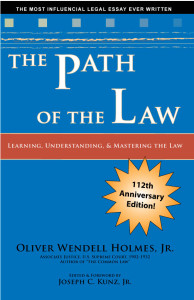 •Title: The Path Of The Law
•Title: The Path Of The Law
Annotated Law Student Edition
•Sub-title: Learning, Understanding,
and Mastering the Law
•Author: Oliver Wendell Holmes, Jr.
•Publisher: Dickson Keanaghan, LLC
•Publication Date: 2009
•ISBN: 978-1933230-08-5
•Book’s Website
How To Think Like A Good Successful Lawyer

Introduction
The thoughtful reader of The Path of the Law will enjoy the sensation of having at his side a guide, philosopher, and teacher who carefully guides him to learning, understanding, and mastering the law. To read and re-read this book is to experience taking on some of the things he has learned from a great teacher and to become excited about the subject too.
The Path of the Law will enjoy the sensation of having at his side a guide, philosopher, and teacher who carefully guides him to learning, understanding, and mastering the law. To read and re-read this book is to experience taking on some of the things he has learned from a great teacher and to become excited about the subject too.
What Is This Book About?
Many changes and improvements have occurred in the legal profession and education since Holmes wrote this essay in 1897. But in this book, Holmes is not concerned with the practical minute details of learning about the law: “Theory is my subject, not practical details.
The modes of teaching have been improved since my time, but ability and industry will master the raw material with any mode. Theory is the most important part of the dogma of the law, as the architect is the most important man who takes part in the building of a house.”
Who Was Holmes?
Holmes was in a position to speak about American law with great authority. After graduating from Harvard with his law degree, he taught law there. He then served for 20 years on the Supreme Judicial Court of Massachusetts. Then he was appointed to the U.S. Supreme Court as an Associate Justice, where he served for 30 years.
Despite his fancy titles and extensive experience, Holmes never talks down to the reader of this book. Holmes’ evident love of the law and his desire to help others understand this attraction is loud and clear to the reader. Holmes uses many easy-to-understand examples throughout the essay to make his point.
The “Bad Man Theory” and “Morality Vs. Law”
The quality and simplicity of Holmes’ writing are reason enough to attract readers – especially law students. His illustrations are chosen from vast experiences and are like vivid pictures flashed on a small screen.
Everyone’s favorite illustration is usually Holmes’ explanation of his “bad man theory.” Holmes explains “that a bad man has as much reason as a good one for wishing to avoid an encounter with the public force, and therefore you can see the practical importance of the distinction between morality and law.”
In other words, a bad man will want only to know the material consequences of his conduct; he will not be motivated by morality or conscience. This example sets the stage for most of the book. Holmes puts a lot of effort into giving examples of the differences between morality and law.
History and Tradition
A large portion of the book discusses the importance of history, or tradition, as an essential part of the study of law. Holmes tells us that “The rational study of law is still to a large extent the study of history. History must be a part of the study, because without it we cannot know the precise scope of rules which it is our business to know.
It is a part of the rational study, because it is the first step toward an enlightened skepticism, that is, toward a deliberate reconsideration of the worth of those rules.”
Isn’t This Book Outdated?
The hasty reader might assume that this book was written too long ago to be of any practical use to a modern law student or lawyer. But a careful reader will immediately realize that Holmes has much to offer us today. Holmes sums up his entire book in two short paragraphs:
“I take it for granted that no hearer of mine will misinterpret what I have to say as the language of cynicism. The law is the witness and external deposit of our moral life. Its history is the history of the moral development of the race. The practice of it, despite popular jests, tends to make good citizens and good men.
When I emphasize the difference between law and morals I do so with reference to a single end, that of learning and understanding the law. For that purpose you must definitely master its specific marks, and it is for that I ask you for the moment to imagine yourselves indifferent to other and greater things.”
“If a man goes into law it pays to be a master of it, and to be a master of it means to look straight through all the dramatic incidents and to discern the true basis for prophecy. Therefore, it is well to have an accurate notion of what you mean by law, by a right, by a duty, by malice, intent, and negligence, by ownership, by possession, and so forth.”
Conclusion
Those reading this book before entering law school should try to re-read it several times during their law school studies. Then, you will begin to understand more of The Path of the Law each time you read it and begin to understand what Holmes was trying to tell us – at a deeper level – and enjoy his message even more.


